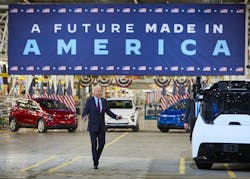GM, POSCO building Quebec plant to serve EV Battery Supply Chain
General Motors, which has vowed to go all-electric in coming decades, announced a plan to bolster its battery supply chain with a new manufacturing facility in Canada.
GM and POSCO Chemical are teaming up and working with the national and provincial governments to build a cathode active material (CAM) production plant in Bécancour, Quebec. The $400 million facility would provide the CAM needed for GM’s Ultium batteries.
The Ultium platform is integral to GM’s growing fleet of EVs such as the Chevrolet Silverado EV, GMC Hummer and Cadillac LYRIQ. GM launched its EV-focused Factory Zero in Michigan last year (see photo) to build more electric vehicles and is targeting manufacture of 30 EV models by 2025.
“GM and our supplier partners are creating a new, more secure and more sustainable ecosystem for EVs, built on a foundation of North American resources, technology and manufacturing expertise,” said Doug Parks, GM executive vice president, Global Product Development, Purchasing and Supply Chain. (See supply chain graphic in image gallery). “Canada is playing an important role in our all-electric future, and we are grateful for the strong support we have received from local, provincial and national officials to grow a North American-focused EV value chain.”
The Quebec site will process CAM, a key battery material consisting of components like processed nickel, lithium and other materials representing about 40% of the cost of a battery cell.
Some industry analysts are worried about the supply chain for nickel, a key element in current EV battery production, due to Russia’s war against the Ukraine. Russia is a major supplier of nickel.
Canada, however, is also one of the world’s leading nickel producers and the largest outside Asia, according to reports. The country produces close to 210,000 metric tons annually.
GM is also having a Lordstown, Ohio battery plant built as well as another components facility in New York.
The companies previously announced plans to form a CAM processing joint venture late last year, majority owned by South Korea-based POSCO Chemical. Construction on the new facility, which the joint venture will operate, will begin immediately and will create approximately 200 jobs.
“POSCO Chemical is set to expand battery material supplying capability across North America through establishing a cathode material plant in Canada,” said Min Kyung-Zoon, CEO of POSCO Chemical. “We will lead the successful transition to the EV era by further strengthening the strategic partnership with GM and securing a production line with world-class technological competitiveness.”
By the end of 2025, GM plans to have capacity to build 1 million electric vehicles in North America, and the company targets the majority of components by value to be sustainably sourced, processed or manufactured in North America.
About the Author
Rod Walton, EnergyTech Managing Editor
Managing Editor
For EnergyTech editorial inquiries, please contact Managing Editor Rod Walton at [email protected].
Rod Walton has spent 17 years covering the energy industry as a newspaper and trade journalist. He formerly was energy writer and business editor at the Tulsa World. Later, he spent six years covering the electricity power sector for Pennwell and Clarion Events. He joined Endeavor and EnergyTech in November 2021.
Walton earned his Bachelors degree in journalism from the University of Oklahoma. His career stops include the Moore American, Bartlesville Examiner-Enterprise, Wagoner Tribune and Tulsa World.
EnergyTech is focused on the mission critical and large-scale energy users and their sustainability and resiliency goals. These include the commercial and industrial sectors, as well as the military, universities, data centers and microgrids. The C&I sectors together account for close to 30 percent of greenhouse gas emissions in the U.S.
He was named Managing Editor for Microgrid Knowledge and EnergyTech starting July 1, 2023
Many large-scale energy users such as Fortune 500 companies, and mission-critical users such as military bases, universities, healthcare facilities, public safety and data centers, shifting their energy priorities to reach net-zero carbon goals within the coming decades. These include plans for renewable energy power purchase agreements, but also on-site resiliency projects such as microgrids, combined heat and power, rooftop solar, energy storage, digitalization and building efficiency upgrades.

